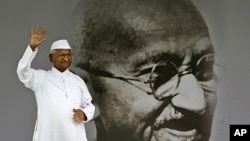Less than six months ago, most people did not know Anna Hazare outside his home state of Maharashtra in western India, where he has long campaigned for social and political change.
After leaving his job as an army driver in the 1970’s, Hazare focused attention on transforming the drought affected village to which he belonged - Ralegan Siddhi in Maharashtra.
He spearheaded a movement to build irrigation systems to harness rain water and to grow trees. Impoverished villagers began to harvest lush crops and earn a good income. Ralegan Sidhi won the label of a model village.
Simultaneously, Hazare campaigned for social transformation, and led a movement against the consumption of alcohol and tobacco in his village, which sometimes drew controversy. Media reports have alleged he used hardline tactics such as public beatings for those who violated the drinking ban.
National emergence
In the 1990’s Hazare turned his attention to fighting corruption in Maharashtra, and began using hunger strikes to publicly shame officials into taking action. His fasts forced two ministers to resign and prompted the state government to probe graft allegations against four other ministers.
The social activist emerged on the national stage in April when he used a four-day fast to force the government to draft legislation for an anti corruption watchdog.
His protest, held under the glare of television cameras, garnered widespread attention in a nation where revelations of multi billion dollar corruption scams had shocked people who were used to stories of official corruption. That hunger strike was called off on the promise that the government would create a powerful ombudsman to fight graft.
Raghunandan Thoniparambil, who has a website called ipaidabribe, says Hazare successfully turned the spotlight on graft. “One big thing, one of the biggest gain out of this is that corruption has remained on the front page for the last one year, and I think for just that alone we need to compliment Team Anna for what they have done. Everybody is now talking about corruption,” Thoniparambil stated.
Fighting corruption
Hazare launched his second hunger strike on August 16 after accusing the government of not keeping its word and introducing what he calls a weak anti-corruption bill in parliament.
His campaign drew unprecedented public support after the government briefly arrested him to prevent the hunger strike.
In Hazare’s latest fast, he is dressed in white clothes and wears a white cap, and is frequently photographed with a huge portrait of Mahatma Gandhi behind him. His use of hunger strikes and calls for non violence echo Gandhi's campaign, and Hazare calls his own campaign India’s second independence struggle.
But Gandhi’s great grandson, Tushar Gandhi, says there are crucial differences in the way the two leaders have used fasting as an instrument of protest. Mahatma Gandhi is also known in India as “bapu” or father.
“With Anna it is more of an attempt to browbeat the government into absolute surrender and submission. It definitely is an attempt to arm twist.," Gandhi said. "With Bapu it was in his own words he said that my fast is an act of love to bring a friend back on the straight and narrow and not an attempt to vanquish an enemy….”
Despite the criticism, there is little doubt that Hazare has resonated with the public. While some political analysts question whether his campaign will succeed in rooting out widespread and deep-rooted graft, the social activist says he is willing to sacrifice his life for the cause.














